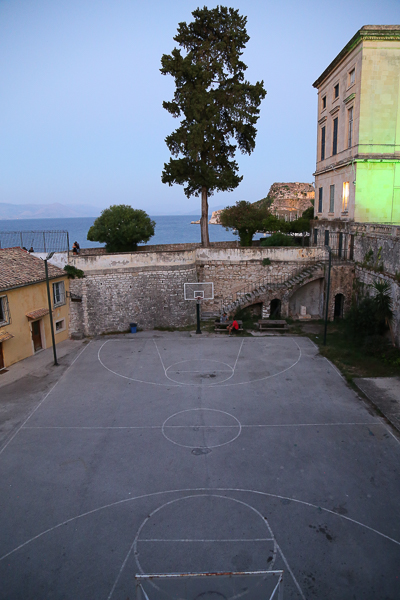
It was a 1300 km road trip through the Western Balkans, and we kicked off on an idyllic Greek island with no road access to the mainland except by car ferry.

But perhaps there was no better starting point for a Balkan trip than the fortified island of Corfu, for centuries the impenetrable gate to the Western Balkans. Until 200 years ago this was the head of a chain of Venetian maritime bastions defending the Adriatic Sea from the Ottoman Turks, when Corfu was culturally analogous to Kotor or Zadar along the modern day coastline of Montenegro and Croatia.

There was also a very practical reason. Corfu's Venetian-built old town is a charming UNESCO World Heritage Site, but most importantly it features the closest airport for our planned entrance into southern Albania, making possible a grand Balkan trip from south to north without backtracking.

So we booked cheap flights from London Gatwick, flying into Corfu and out from Ljubljana, Slovenia, traveling through 6 countries in 22 days starting from this cultural crossroad of Greeks and Venetians, the French and the British.

Unmistakably French is the row of classy cafes lining the side of the old Venetian square, modelled after the then state-of-the-art Rue de Rivoli in Paris by Napoleon's commissioners. Within fifteen years of its completion the island would change hands again and the British would take over.

North of the square the British commissioner built his splendid neoclassical palace that would later serve as summer residence for the Greek royalty, before being turned into the Museum of Asian Art for its collection of Japanese ukiyoe prints.

With the British came the game of cricket, still played by local teams on the southern side of the massive Venetian square known as the Liston. Beyond the cricket grounds the British also erected an eye-catching neoclassical rotunda, just a stone's throw from the old Venetian castle.

Now separated from the mainland by an artificial sea moat, Corfu's Venetian castle was once Christian Europe's most stalwart outpost against the advancing tide of the Turks, successfully fending off multiple Ottoman sieges through the centuries. As for the elegant doric temple by the seaside? That was another fanciful addition by the British during their four decades of rule, a miniscule sliver of time relative to Corfu's 2800-year-old history.

Another British import aside from cricket was the plantations of kumquat, introduced from Southern China by an English botanist and now thriving in Corfu's Mediterranean sunshine. It was impossible to pass through the old town without being seduced by samples of kumquat liqueur, candied kumquat or my favorite of all, kumquat gelato.

For the definitive postcard image of Corfu one can take the frequent Bus 2A to Kanoni, hike down to the whitewashed chapel and perhaps take a water taxi to legendary islet of Pontikonisi, held to be the ship of Ulysses -- yes, of Homeric fame -- turned into a rock by Poseidon himself.

It is no secret that Cafe Kanoni offers the best panorama of Pontikonisi from its cliff-top location, but most patrons head for the open-air terrace and miss the elegant mirror-lined dining room with arguably an even better view. We ended up spending much our afternoon here, sipping Greek coffee and watching planes land at the neighbouring airport.

We wrapped up the day with a sunset stroll on the promenade just above Faliraki beach, the Venetian fortress on one side and yacht clubs on the other. The dry gyro pitas at the popular Meraklis were several notches below anything in Athens and thus unworthy of a review, but we did come across a good lunch spot.
Restaurant Review: TAVERNA TO DIPORTO (Corfu) (Location Map)

Corfu is famously expensive compared with much of Greece with its abundance of British pubs and Italian osterias, catering mainly to casual tourists on sun holidays. So we were glad to find this old-fashioned taverna within the town's labyrinth of narrow Venetian alleys, still proudly displaying its name only in Greek while serving up Corfiot favorites to its regulars.

One of the local favorites is the Venetian-influenced Bourdeto which, unlike the Croatian Brudet of related origin, is a whole simmered fish rather than a stew of fish chunks. Don't expect the fish scales to be meticulously cleaned, but our scorpion fish was extremely fresh with its firm meat lightly simmered in a thick broth of tomato, garlic and spicy cayenne peppers.

Perhaps the most famous Corfiot dish, the Greek version of Sofrito is a slow-braised veal steak in white wine vinegar, onions and garlic. We both agreed that the Bourdeto was the better dish, though it was impossible to complain about a 10 euros main course in old town Corfu.
Meal for Two Persons
| Bourdeto | 12 euros |
| Sofrito | 10 euros |
| Ionian Beer | 4 euros |
| Water | 2 euros |
| TOTAL | 28 euros (CAD$42) |

We booked two nights at a nicely renovated 19th century apartment near the new port, walkable to the old town in 10 minutes and a shorter stroll to the ferry terminal for the hydrofoil to Albania. The collection of complimentary kumquat marmalade, kumquat body lotion and organic honey from the ownership's sister company was a memorable touch.

The next morning we checked out sharply at 08:00 in anticipation for our hydrofoil ride to the Albanian resort town of Saranda. The queue at the immigration office was confusing, the shuttle bus to the boat was barely organized and our hydrofoil's departure was delayed by 40 minutes. Nearly 10 years since our last visit to Greece, some things still haven't changed.
No comments:
Post a Comment